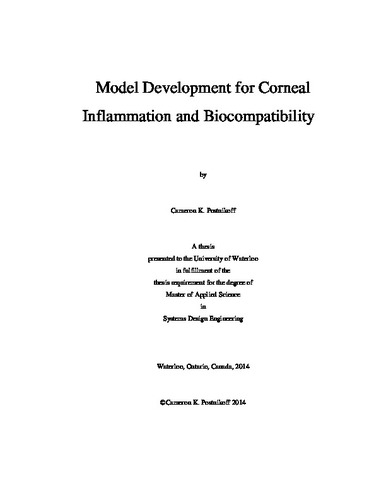| dc.description.abstract | The ocular surface presents a complex environment where the corneal epithelium has to interact with the tear film, the blink, and the many proteins, lipids, and signaling molecules that exist. As a contact lens is placed into this environment, homeostasis may be unbalanced, and it may affect the overall patient satisfaction with lenses. In order to study this effect at a cellular level, in vitro models offer the ability for cost-effective, tailored, and biologically-relevant methods to investigate material biocompatibility with the ocular surface.
The development of an in vitro curved, stratified, human corneal epithelium has been instrumental in allowing for a more detailed investigation into biocompatibility at the ocular surface. This advancement was followed by the creation of the tear replenishment system, which has incorporated the dynamic, fluidic effect of blinking and tear exchange, in combination with the in vitro epithelial model. While these models have been used to probe cytotoxicity from contact lenses soaked in benzalkonium chloride, contact lens and solution interactions had yet to be studied using these models.
Solution-induced corneal staining (SICS) is a clinical phenomenon that has led to the understanding that different lens and solution combinations interact differentially with the cornea. The first major goal of the thesis was to use in vitro models of the corneal epithelium to investigate SICS. It was determined that cell death is likely not responsible for SICS, but cell death may be implicated in disruption of the epithelial barrier which could evoke microbial susceptibility.
While the above models offer an advanced approach for the study of corneal biocompatibility, they lack incorporation of the innate immune system. Before an inflammatory component may be incorporated into an in vitro model, an improved understanding of the role of ocular surface immune cells is required. Hundreds of thousands of neutrophils are accumulated on the closed eye following sleep, and these neutrophils show a differential phenotype from blood-isolated neutrophils. The second main goal of the thesis demonstrated that incubation of blood-isolated neutrophils under closed eye conditions is not responsible for the drastic change in inflammatory phenotype.
Ultimately, this work has demonstrated the importance of in vitro models for the study of ocular phenomena and there is a great potential for the use of these models to better understand inflammation and biocompatibility of the cornea. | en |

